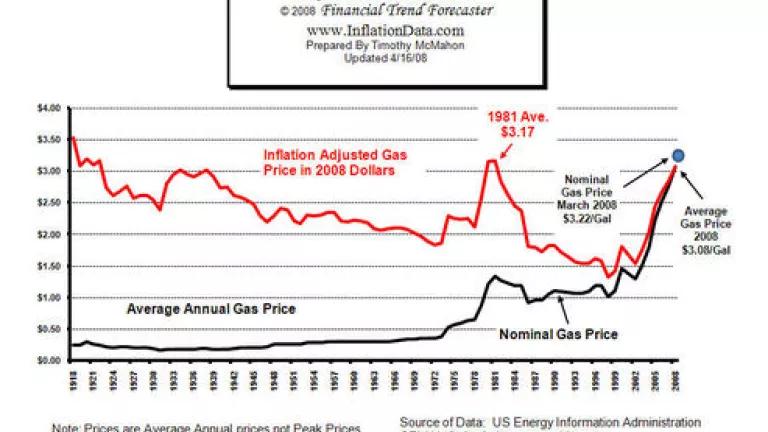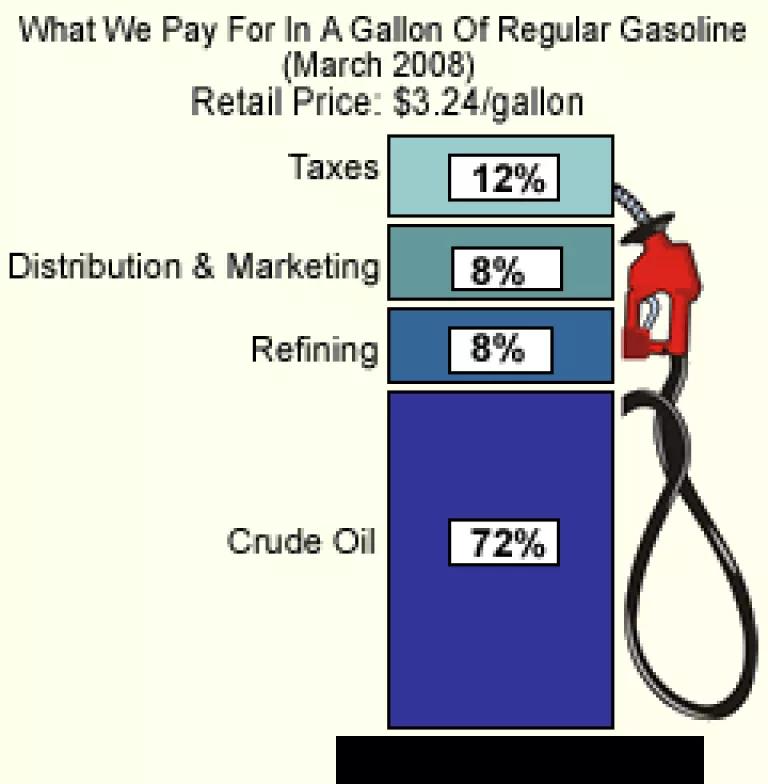
Pulling up to the pump nowadays is about as much fun as a trip to the dentist. But is the pain we feel really worse than previous price runups? In a word, yes. The average price of gasoline has recently hit record highs, shown in inflation-adjusted terms in the graph below. The most memorable previous price jump occurred in the early 1980s due to shocks to the system courtesy of OPEC, the global oil cartel.
Price runups are mostly about crude oil as shown in the graphic below from the Department of Energy (by comparison in 2005 crude oil was 48 percent of the total).

We are now in uncharted territory in these markets, with analysts offering a variety of explanations. Regarding supply, what is clear is that in the past decade, OPEC has reasserted its ability to set prices (OPEC now controls about 40% of the market), and has adopted an explicit strategy of regulating prices. Re: Demand, what is clear is the thirst for oil is growing in industrialized countries like the U.S. and taking off in the nations where one-third of humanity resides: China, and to a lesser degree India.
As much as 90 percent of this resource belongs to national, not private, oil companies. As of 2004, the largest of them (Saudi Aramco) owned about 260 billion barrels of oil. ExxonMobil’s reserves are less than five percent of that. Small wonder that President Bush “ain’t too proud to beg” the Saudis to increase production.
What we’re overlooking is our power in the marketplace: We overshadow every other nation in oil use, accounting for about one-fourth of total world consumption. This means we have an outsized influence on prices, since we have “monopsony power” as an economist would say, which is the buyer’s equivalent to a seller’s monopoly power. This means that to tackle high prices we should turn from playing to our weak suit in the marketplace – control over supply – and trump OPEC by chipping away at our 20-million-barrel-a-day oil habit.
So how do we do that? First, we can take some commonsense -- and painless, especially compared to shelling out $4 a gallon for gas -- personal actions. NRDC has joined more than a dozen sponsors, including unusual ones (again, we’re in uncharted territory with these prices) like auto and manufacturers and even the oil industry, in a campaign called the “Drive Smarter Challenge.”
The campaign, organized by the Alliance to Save Energy, offers a series of tips for cutting gasoline use and costs. Just go to the website and type in the make, model and year of your car – and you will immediately see how much you can reduce your gasoline costs this year by adopting up to six smart driving measures. You’ll get common-sense tips, money-saving coupons, and fresh ideas that will result in less money moving from your wallet to your gas tank. For example:
- Keeping your tires properly inflated improves gas mileage by around 3 percent, saving up to 20 gallons of gasoline, or almost $65.
- Fixing a car that is noticeably out of tune or has failed an emissions test can improve its gas mileage by an average of 4% —saving up to 25 gallons of gasoline and up to $80. Fixing a faulty oxygen sensor can improve mileage by as much as 40% — saving up to 250 gallons of gasoline or up to $800.
- You can save up to 12 gallons of gasoline per year, or almost $40, by removing an extra 100 pounds of “junk in the trunk” of your vehicle.
NRDC estimates that if every one of us took several simple steps like these we could improve gas mileage by perhaps 10-20 percent, which would reduce fuel consumption by 9-17 percent. This would save about 1.5 million barrels per day, or five times as much as the extra production from Saudi Arabia in response to the President’s plea.
These steps will buy some short-term relief. A bigger step would be to buy a hybrid if you’re in the market for a car. For example, a Toyota Camry hybrid boosts fuel economy by about a third compared to the conventional version, which assuming a gas price of $3.72 a gallon saves about 600 bucks a year. For other side-by-side comparisons go to this government web site.
As I’ve written about before, in the months and years ahead we can and must secure our energy future by doing much more to cut our oil use, among other things by adopting higher performance standards for vehicles and fuels, boosting investment in public transportation, and putting global warming pollution caps in place. Even the Administration admits that higher prices mean that proposed fuel economy standards could be ratcheted up. And freeing up states to adopt California's vehicle greenhouse gas emission standards by 2020 would also boost efficiency higher than the target set in last year’s energy bill, as my colleague David Doniger has described on his blog.
And of course key to long-term energy security is enacting the Lieberman-Warner Climate Security Act, which a new analysis shows would save more than three million barrels of oil a day by 2030 via incentives for a shift to cutting-edge technologies such as plug-in hybrid cars and clean biofuels.